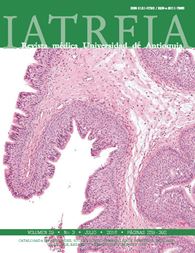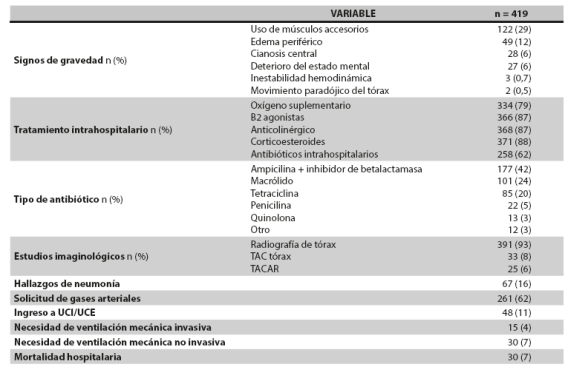Uso adecuado de antibióticos en pacientes con exacerbaciones de EPOC atendidos en un hospital de Medellín, Colombia
DOI:
https://doi.org/10.17533/udea.iatreia.v29n3a02Palabras clave:
antibióticos, adherencia, EPOC, exacerbación, guías GOLDResumen
Objetivo: evaluar la adherencia a las guías de uso de antibióticos en pacientes con EPOC exacerbada y explorar la asociación entre dicha prescripción y los desenlaces clínicos.
Métodos: estudio de cohorte retrospectivo con pacientes admitidos entre el 1 de enero del 2010 y el 31 de diciembre del 2012 con diagnóstico de EPOC. Se registraron variables sociodemográficas, clasificación espirométrica, uso de oxígeno domiciliario, exacerbaciones en el último año, uso reciente de antibióticos, necesidad de ventilación mecánica, vacunación previa, comorbilidades, presentación clínica, indicación para el uso de antibióticos, tratamiento y estado al alta.
Resultados: de 419 pacientes 59 % (n = 247) eran mujeres, la mediana de la edad fue de 76 años, 61,8 % tenían diagnóstico clínico, 74,7 % tenían instaurado algún tratamiento ambulatorio y 11 % habían sido tratados anteriormente para exacerbación de EPOC. De 170 pacientes con indicación para el uso de antibióticos hubo prescripción en 140 (82 %), mientras que se les formularon a 118 (47,4 %) de los 249 que no cumplían ningún criterio para el uso de los mismos. Se encontró una mayor tasa de mortalidad en el grupo que requería antibióticos.
Conclusiones: se observó un aceptable nivel de adherencia a las guías en el uso de antibióticos en los casos indicados. Sin embargo, el porcentaje de pacientes a los que se les prescribieron antibióticos innecesariamente parece ser mayor de lo esperado y amerita investigación adicional.
Descargas
Citas
(1.) Dixit D, Bridgeman MB, Andrews LB, Narayanan N, Radbel J, Parikh A, et al. Acute exacerbations of chronic obstructive pulmonary disease: diagnosis, management, and prevention in critically ill patients. Pharmacotherapy. 2015 Jun;35(6):631-48. DOI 10.1002/phar.1599.
(2.) Snow V, Lascher S, Mottur-Pilson C; Joint Expert Panel on Chronic Obstructive Pulmonary Disease of the American College of Chest Physicians and the American College of Physicians-American Society of Internal Medicine. Evidence base for management of acute exacerbations of chronic obstructive pulmonary disease. Ann Intern Med. 2001 Apr;134(7):595-9.
(3.) Vestbo J, Hurd SS, Agustí AG, Jones PW, Vogelmeier C, Anzueto A, et al. Global strategy for the diagnosis, management, and prevention of chronic obstructive pulmonary disease: GOLD executive summary. Am J RespirCrit Care Med. 2013 Feb;187(4):347-65.
(4.) Myint PK, Lowe D, Stone RA, Buckingham RJ, Roberts CM. U.K. National COPD Resources and Outcomes Project 2008: patients with chronic obstructive pulmonary disease exacerbations who present with radiological pneumonia have worse outcome compared to those with non-pneumonic chronic obstructive pulmonary disease exacerbations. Respiration. 2011;82(4):320-7. DOI 10.1159/000327203.
(5.) Saint S, Bent S, Vittinghoff E, Grady D. Antibiotics in chronic obstructive pulmonary disease exacerbations. A meta-analysis. JAMA. 1995 Mar;273(12):957-60.
(6.) Daniels JM, Snijders D, de Graaff CS, Vlaspolder F, Jansen HM, Boersma WG. Antibiotics in addition to systemic corticosteroids for acute exacerbations of chronic obstructive pulmonary disease. Am J Respir-Crit Care Med. 2010 Jan;181(2):150-7.
(7.) Fantin B. Reduced antibiotic pressure for the treatment of acute exacerbation of chronic obstructive pulmonary disease: back to the future. Clin Infect Dis. 2010 Jul;51(2):150-2.
(8.) Tsai CL, Ginde AA, Blanc PG, Camargo CA. Improved care of acute exacerbation of chronic obstructive pulmonary disease in two academic emergency departments. Int J Emerg Med. 2009 Feb;2(2):111-6.
(9.) Stefan MS, Rothberg MB, Shieh MS, Pekow PS, Lindenauer PK. Association between antibiotic treatment and outcomes in patients hospitalized with acute exacerbation of COPD treated with systemic steroids. Chest. 2013 Jan;143(1):82-90.
(10.) Stockley RA, O›Brien C, Pye A, Hill SL. Relationship of sputum color to nature and outpatient management of acute exacerbations of COPD. Chest. 2000 Jun;117(6):1638-45.
(11.) Boggon R, Hubbard R, Smeeth L, Gulliford M, Cassell J, Eaton S, et al. Variability of antibiotic prescribing in patients with chronic obstructive pulmonary disease exacerbations: a cohort study. BMC PulmMed. 2013 May;13:32.
(12.) Molfino NA. Tratamiento de pacientes con enfermedad pulmonar obstructiva crónica (EPOC) por médicos clínicos generales. Medicina (B Aires). 2004 Sep-Oct;64(5):445-54.
(13.) Tang CY, Taylor NF, McDonald CF, Blackstock FC. Level of adherence to the GOLD strategy document for management of patients admitted to hospital with an acute exacerbation of COPD. Respirology. 2014 Nov;19(8):1191-7.
(14.) Masoompour SM, Mohammadi A, Mahdaviazad H. Adherence to the Global Initiative for Chronic Obstructive Lung Disease guidelines for management of COPD: a hospital-base study. ClinRespir J. 2014 Oct.
(15.) Khialani B, Sivakumaran P, Keijzers G, Sriram KB. Emergency department management of acute exacerbations of chronic obstructive pulmonary disease and factors associated with hospitalization. J Res Med Sci. 2014 Apr;19(4):297-303.
(16.) Fanning M, McKean M, Seymour K, Pillans P, Scott I. Adherence to guideline-based antibiotic treatment for acute exacerbations of chronic obstructive pulmonary disease in an Australian tertiary hospital. Intern Med J. 2014 Sep;44(9):903-10.
(17.) Roede BM, Bindels PJ, Brouwer HJ, Bresser P, de Borgie CA, Prins JM. Antibiotics and steroids for exacerbations of COPD in primary care: compliance with Dutch guidelines. Br J Gen Pract. 2006 Sep;56(530):662-5.
(18.) Rothberg MB, Pekow PS, Lahti M, Brody O, Skiest DJ, Lindenauer PK. Antibiotic therapy and treatment failure in patients hospitalized for acute exacerbations of chronic obstructive pulmonary disease. JAMA. 2010 May;303(20):2035-42.
Publicado
Cómo citar
Número
Sección
Licencia
Derechos de autor 2016 Iatreia

Esta obra está bajo una licencia internacional Creative Commons Atribución-CompartirIgual 4.0.
Los artículos publicados en la revista están disponibles para ser utilizados bajo la licencia Creative Commons, específicamente son de Reconocimiento-NoComercial-CompartirIgual 4.0 Internacional.
Los trabajos enviados deben ser inéditos y suministrados exclusivamente a la Revista; se exige al autor que envía sus contribuciones presentar los formatos: presentación de artículo y responsabilidad de autoría completamente diligenciados.



















